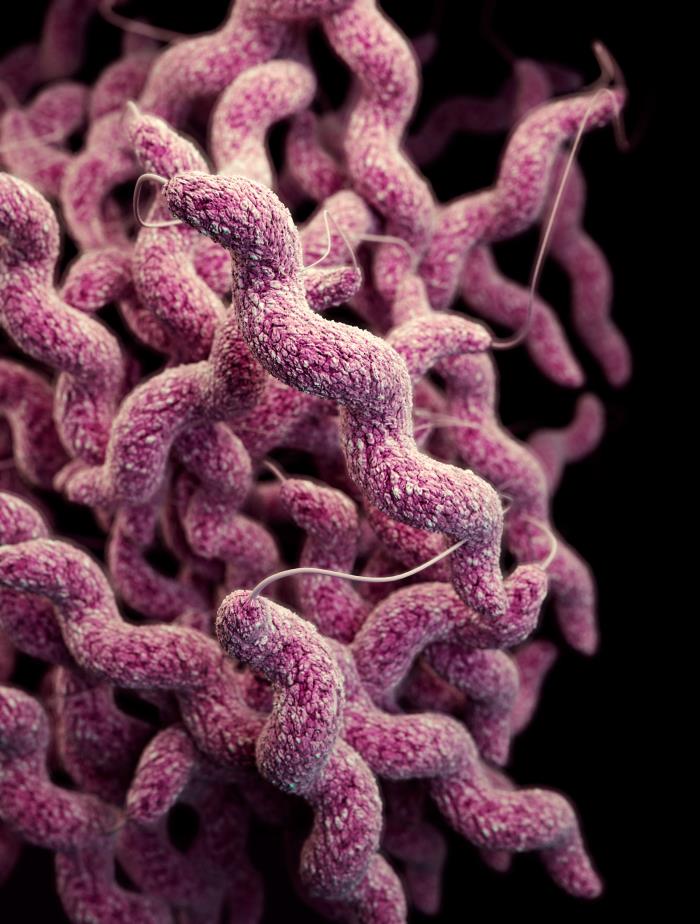County public health and environmental health officials are investigating an outbreak of campylobacteriosis associated with eating at Alejandro’s Taqueria (Alejandro’s) on Texas Street in Fairfield.

Image/CDC
“There have been increased reports of laboratory-confirmed campylobacteriosis since the beginning of June,” said Dr. Michael Stacey, Solano County Deputy Health Officer. “So far, 32 Campylobacter cases have been reported to us this month, almost double the number of reported cases that we had for the whole month of June in 2015.”
The investigation is still underway; multiple ill individuals interviewed so far have reported eating at Alejandro’s between May 26-May 29. However, it is possible that the dates of concern for eating at Alejandro’s include some number of days before and after the dates that have been reported.
“Our top priority is the safety and health of the public,” said Stacey. “We are working with environmental health, our public health laboratory and the California Department of Public Health to identify the source of the outbreak and to prevent further cases from occurring. We will provide the public with more details once we obtain further information from the investigation.”
The restaurant was closed on June 8, 2016 as soon as it was identified as a potential source of the outbreak. The restaurant will remain closed until public health and environmental health officials are assured that it is safe for it to open.
“To ensure that there is no further risk to the public, we are closing the restaurant as a precaution during the investigation,” said Jagjinder Sahota, Solano County Environmental Health Manager. “The restaurant owners are cooperating with us fully.”
Campylobacteriosis is one of the most common causes of diarrheal illness in the United States. Illness usually occurs two to five days after exposure to Campylobacter and lasts about a week. The illness is usually mild and many people with campylobacteriosis show no symptoms at all. Though rare, in persons with weakened immune systems, the bacteria can spread to the bloodstream and cause serious infection.
Symptoms of campylobacteriosis include diarrhea, abdominal cramps and fever. The diarrhea may be bloody and may be accompanied by nausea and vomiting. People with diarrhea, especially children in day care and people who handle food, should not go to school, day care or work until 48 hours after their diarrhea ends. Almost all persons infected with Campylobacter recover completely.
“We urge anyone who is ill with diarrhea, abdominal cramps and fever to seek medical care so they can be properly assessed and treated,” Stacy added.
Most cases of campylobacteriosis are associated with eating raw or undercooked poultry meat or from cross-contamination of other foods by these items. Outbreaks of Campylobacter have been associated with eating unpasteurized dairy products, drinking contaminated water and contact with infected dogs and cats.
“We would like to take this opportunity to remind our residents to follow some simple food handling practices to prevent campylobacter and other foodborne infections,” Sahota added.
– Cook all meats, especially poultry, thoroughly. If you are served undercooked poultry in a restaurant, send it back for further cooking.
– Prevent cross-contamination in the kitchen by using separate cutting boards for raw meat or poultry and by carefully cleaning all cutting boards, countertops and utensils with soap and hot water after preparing raw meat or poultry.
– Wash your hands with soap and water before preparing food and immediately after handling raw meat and poultry.
– Avoid drinking unpasteurized milk and untreated surface water.
– Wash your hands well with soap and water after using the bathroom, changing diapers, or handling pets, including animals at petting zoos. Make sure children also wash their hands well after going to the bathroom or handling pets.
Related:


One thought on “California: Campylobacter outbreak linked to Solano County restaurant”